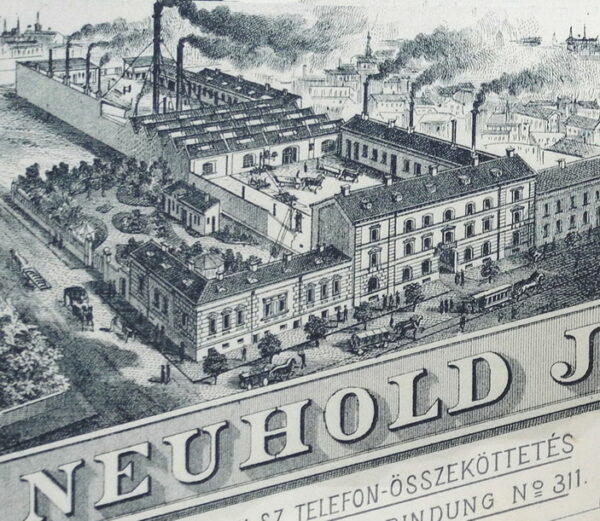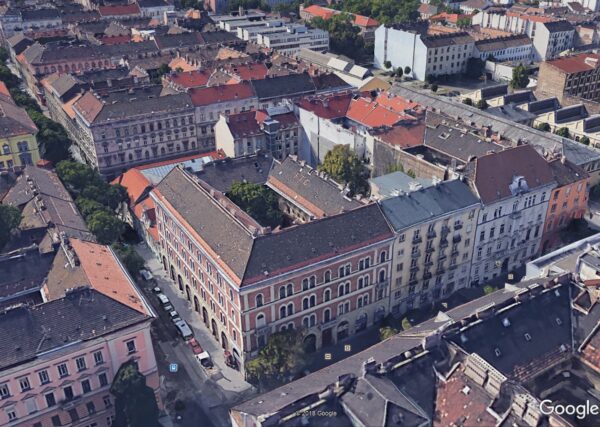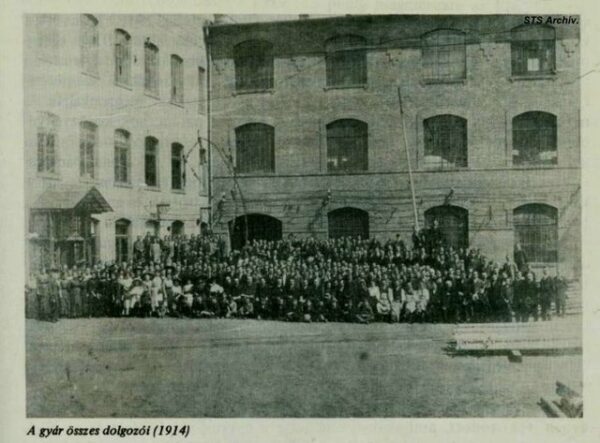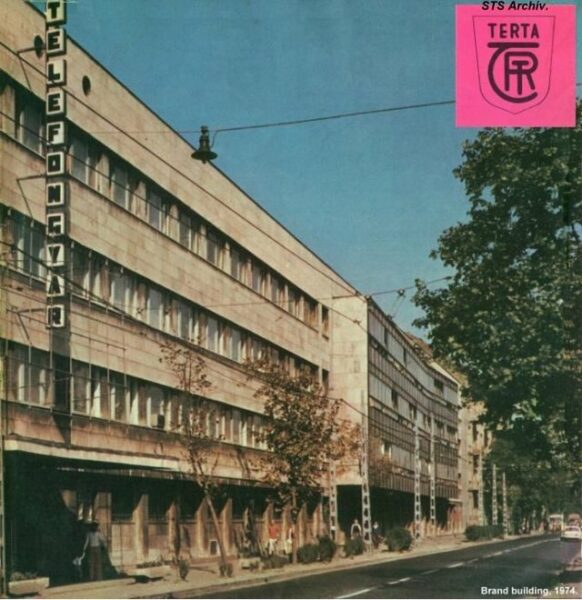Telephone factory ltd

The Telephone Factory's predecessor companies date back to 1874, when János Neuhold founded his first factory, repairing railway telegraphs. In 1883, the company became the first in the country to start manufacturing railway safety equipment. The factory was doing well, and after 5 years it had 150 workers and built a new factory in Dohány Street.
They became involved in telephone production in 1889 because the Fischer company, which had won the state order, was unable to deliver, so it was divided between the other two bidders, and the Neuhold company also received orders.
In 1891, the company was transformed into a joint stock company, in which Neuhold was the majority owner with Belgian partners. In 1894, Neuhold withdrew from the Neuhold Railway Fittings and Electrotechnical Machinery Company Ltd. because of economic difficulties, and the company effectively ceased to exist. Together with his sons, Neuhold founded a new company, Neuhold & Co., called Neuhold & Co. Railway Equipment and Electrical Machinery, which from 1900 was the Hungarian representative of the Hanover-based Berliner Telephone Company.
The business became successful, with major orders from railway companies including MÁV, thanks to Neuhold's perfection of the Agar telephone signalling system, which allowed telephony between stations using existing bell signalling wires.
After the unexpected death of János Neuhold in 1904, the company was taken over by his son Kornél Neuhold. The cooperation with the Hanover company ended in 1911, and the Telephone Factory Ltd. was founded as the successor of the previous factory with a share capital of 1.5 million crowns, consisting of 7,500 shares with a nominal value of 200 crowns. The majority of the shares, 7275, were acquired by the Hanover company.
The factory was then located on Gizella Road, and its product range included all kinds of electronic and electromechanical signalling equipment, from telephones and fire alarms to complete railway safety equipment and railway semaphore systems, but it also produced telephones, telephone exchanges and galvanic elements. At that time the company won state aid, which was conditional on the continued provision of working and fixed capital, and had to employ mainly Hungarian workers.

During the First World War, it was a war factory, producing munitions such as ammunition, and traditional products were in decline, although the company did produce military radio transmitters.
From 1923, the Telephone Factory also produced radio receivers with detectors, and later radios were made based on Telefunken designs. United Spark, which was a competitor of the Telephone Factory in the radio receiver business, tried to take over the majority of the shares as early as 1923, but only succeeded in 1925. As a result, the railway safety equipment division of United Sparkling was transferred to the Telephone Company. Shortly afterwards, in 1928, the majority of the shares in the Telephone Factory were bought by the American-owned Standard Electricity Co.
In 1926, Telefongyár signed an exclusive contract with Knorr-Bremse AG, so from then on only Telefongyár could produce Knorr brakes in Hungary.
In addition to the production of radio sets (which accounted for the largest share of production), new businesses were also started, such as the production of petrol stations (the first public petrol station in Budapest was not opened until 1924). After the introduction of the penguin, the share capital was set at 1 625 000 pence, consisting of 162 500 shares of 10 pence each.
During the great economic crisis, many marketable but different products were produced to survive, from zippers - the first in Hungary - to alpaca cutlery and boat engines.
In 1933 Standard Electricity Ltd. transferred its shares in the Telephone Factory to the London agent of International Standard Corporation. In the same year, Kornél Neuhold retired.

On the eve of the Second World War, a prerequisite for the orders of the Hungarian Defence Forces was the removal of the Jewish-born chiefs of staff, Imre Székely and Béla Halász. Imre Székely then retired. The factory became a military factory again in 1939, and a new factory building was erected in 1941 to cope with the increase in production. With the entry of the USA into the war, the ownership of the American Standard came under German control. During the war, of course, military radio transmitters, machine telegraphs and radio parts were produced, not only for the Hungarian but also for the German army and navy - the German submarines.
The factory took several hits in late 1944 and early 1945. After the war it was temporarily under Russian control, but was returned to its owners in the summer of 1945.
The factory was nationalised twice. The first time in 1948, but as it was US-owned, it was withdrawn under international pressure, but in December 1949 it became state-owned for good.
The nationalised Telephone Factory produced both civilian and military equipment and operated as a socialist company until the change of regime, when it was privatised in 1991 and bought by Siemens. Under Siemens' control, it operated as Siemens Telefongyár Kft. until 2003, when it ceased to be independent and was merged into Siemens Rt.

Points of interest
In July 1919, Dénes Mihályi, an employee of the Telephone Factory, presented a very interesting device to the public. The device, which the inventor called Telehor, could transmit still images from a distance of up to several kilometres. The telephone company did not pay the patent fee after the invention, and Dénes Mihályi worked for the German company AEG from 1924 onwards and continued the development there.
Sources
https://itf.njszt.hu/intezmeny/telefongyar
Sarolta Czakó, Károly Jenei A Telephone factory history 1876-1976.
https://lazarbibi.blog.hu/2016/03/09/a_telefongyar_tortenete_i_resz
Founded in 1874 (1894)
Date of cessation: 2003
Founders: János Neuhold
Securities issued:
| Telephone factory ltd |
Decisive leaders:
1874-1911 | János Neuhold |
1911-1933 | Kornél Neuhold |
1933- | United Embers |
Main activity: manufacture of railway and telecommunications electronic products
Author: by Domonkos Csaba
Founded in 1874 (1894)
Founders: János Neuhold
Decisive leaders:
1874-1911 | János Neuhold |
1911-1933 | Kornél Neuhold |
1933- | United Embers |
Main activity: manufacture of railway and telecommunications electronic products
Main products are not set
Seats are not configured
Locations are not set
Main milestones are not set
Author: by Domonkos Csaba
Telephone factory ltd

The Telephone Factory's predecessor companies date back to 1874, when János Neuhold founded his first factory, repairing railway telegraphs. In 1883, the company became the first in the country to start manufacturing railway safety equipment. The factory was doing well, and after 5 years it had 150 workers and built a new factory in Dohány Street.
They became involved in telephone production in 1889 because the Fischer company, which had won the state order, was unable to deliver, so it was divided between the other two bidders, and the Neuhold company also received orders.
In 1891, the company was transformed into a joint stock company, in which Neuhold was the majority owner with Belgian partners. In 1894, Neuhold withdrew from the Neuhold Railway Fittings and Electrotechnical Machinery Company Ltd. because of economic difficulties, and the company effectively ceased to exist. Together with his sons, Neuhold founded a new company, Neuhold & Co., called Neuhold & Co. Railway Equipment and Electrical Machinery, which from 1900 was the Hungarian representative of the Hanover-based Berliner Telephone Company.
The business became successful, with major orders from railway companies including MÁV, thanks to Neuhold's perfection of the Agar telephone signalling system, which allowed telephony between stations using existing bell signalling wires.
After the unexpected death of János Neuhold in 1904, the company was taken over by his son Kornél Neuhold. The cooperation with the Hanover company ended in 1911, and the Telephone Factory Ltd. was founded as the successor of the previous factory with a share capital of 1.5 million crowns, consisting of 7,500 shares with a nominal value of 200 crowns. The majority of the shares, 7275, were acquired by the Hanover company.
The factory was then located on Gizella Road, and its product range included all kinds of electronic and electromechanical signalling equipment, from telephones and fire alarms to complete railway safety equipment and railway semaphore systems, but it also produced telephones, telephone exchanges and galvanic elements. At that time the company won state aid, which was conditional on the continued provision of working and fixed capital, and had to employ mainly Hungarian workers.

During the First World War, it was a war factory, producing munitions such as ammunition, and traditional products were in decline, although the company did produce military radio transmitters.
From 1923, the Telephone Factory also produced radio receivers with detectors, and later radios were made based on Telefunken designs. United Spark, which was a competitor of the Telephone Factory in the radio receiver business, tried to take over the majority of the shares as early as 1923, but only succeeded in 1925. As a result, the railway safety equipment division of United Sparkling was transferred to the Telephone Company. Shortly afterwards, in 1928, the majority of the shares in the Telephone Factory were bought by the American-owned Standard Electricity Co.
In 1926, Telefongyár signed an exclusive contract with Knorr-Bremse AG, so from then on only Telefongyár could produce Knorr brakes in Hungary.
In addition to the production of radio sets (which accounted for the largest share of production), new businesses were also started, such as the production of petrol stations (the first public petrol station in Budapest was not opened until 1924). After the introduction of the penguin, the share capital was set at 1 625 000 pence, consisting of 162 500 shares of 10 pence each.
During the great economic crisis, many marketable but different products were produced to survive, from zippers - the first in Hungary - to alpaca cutlery and boat engines.
In 1933 Standard Electricity Ltd. transferred its shares in the Telephone Factory to the London agent of International Standard Corporation. In the same year, Kornél Neuhold retired.

On the eve of the Second World War, a prerequisite for the orders of the Hungarian Defence Forces was the removal of the Jewish-born chiefs of staff, Imre Székely and Béla Halász. Imre Székely then retired. The factory became a military factory again in 1939, and a new factory building was erected in 1941 to cope with the increase in production. With the entry of the USA into the war, the ownership of the American Standard came under German control. During the war, of course, military radio transmitters, machine telegraphs and radio parts were produced, not only for the Hungarian but also for the German army and navy - the German submarines.
The factory took several hits in late 1944 and early 1945. After the war it was temporarily under Russian control, but was returned to its owners in the summer of 1945.
The factory was nationalised twice. The first time in 1948, but as it was US-owned, it was withdrawn under international pressure, but in December 1949 it became state-owned for good.
The nationalised Telephone Factory produced both civilian and military equipment and operated as a socialist company until the change of regime, when it was privatised in 1991 and bought by Siemens. Under Siemens' control, it operated as Siemens Telefongyár Kft. until 2003, when it ceased to be independent and was merged into Siemens Rt.

Points of interest
In July 1919, Dénes Mihályi, an employee of the Telephone Factory, presented a very interesting device to the public. The device, which the inventor called Telehor, could transmit still images from a distance of up to several kilometres. The telephone company did not pay the patent fee after the invention, and Dénes Mihályi worked for the German company AEG from 1924 onwards and continued the development there.
Sources
https://itf.njszt.hu/intezmeny/telefongyar
Sarolta Czakó, Károly Jenei A Telephone factory history 1876-1976.
https://lazarbibi.blog.hu/2016/03/09/a_telefongyar_tortenete_i_resz